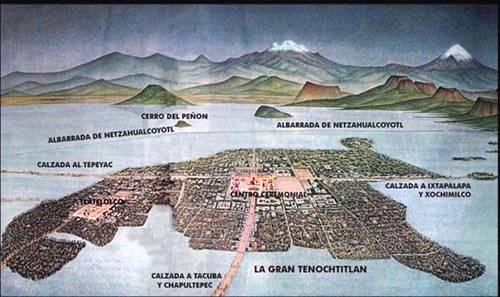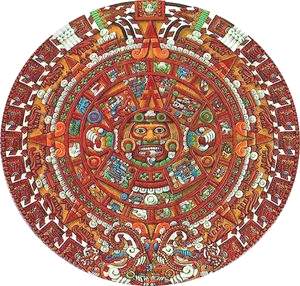The Aztec people also enjoyed a type of dramatic presentation, although it could not be called theater. Some were comical with music and acrobats, others were staged dramas of their gods. After the conquest, the first Christian churches had open chapels reserved for these kinds of representations. Plays in Nahuatl, written by converted Indians, were an important instrument for the conversion to Christianity, and are still found today in the form of traditional pastorelas, which are played during Christmas to show the Adoration of Baby Jesus, and other Biblical passages.

México-Tenochtitlan
Education
Until the age of fourteen, the education of children was in the hands of their parents, but supervised by the authorities of their calpulli. Periodically they attended their local temples, to test their progress.
Part of their education was a collection of sayings, called huehuetlatolli ("The sayings of the old"), that represented the Aztecs' ideals. It included speeches and sayings for every occasion, the words to salute the birth of children, and to say farewell at death. Fathers admonished their daughters to be very clean, but not to use makeup, because they would look like ahuianis. Mothers admonished their daughters to support their husbands, even if they turn out to be humble peasants. Boys were admonished to be humble, obedient and hard workers.
Boys and girls went to school at age 15. Probably this was one of the first societies that required education for all its members, without regard of sex or social status. There were two types of educational institutions. The telpochcalli or House of the Young, taught history, religion, military fighting arts, and a trade or craft (such as agriculture or handicrafts). Some of the telpochcalli students were chosen for the army, but most of them returned to their homes. The calmecac, attended mostly by the sons of pillis, was focused on turning out leaders (tlatoque), priests, scholars/teachers (tlatimini), healers (tizitl) and codex painters (tlacuilos). They studied rituals, ancient and contemporary history, literacy, calendrics, some elements of geometry, songs (poetry), and, as at the telpochcalli, military arts.
Each Calpulli was specialized in some handicrafts, and this was an important part of the income of the city. So the teaching of handicraft was very apreciated.
Also, the healers or Tizitl had several specialities. Some were trained to just look and classify medicinal plants, others were training just in the preparation of medicines that were sold in special places (Tlapalli), more than a hundred preparations are known, including deodorants, remedies for smelly feet, dentifric paste etc. Also there were Tizitl specialized in surgery, digestive disease, teeth and nose, skin diseases etc.
Aztec teachers or Tlatimine, propounded a spartan regime of education – cold baths in the morning, hard work, physical punishment, bleeding with maguey thorns and endurance tests – with the purpose of forming a stoical people.
There is contradictory information about whether calmecac was reserved for the sons and daughters of the pillis; some accounts said they could choose where to study. It is possible that the common people preferred the telpochcalli, because a warrior could advance more readily by his military abilities; becoming a priest or a tlacuilo was not a way to rise rapidly from a low station.
Girls were educated in the crafts of home and child raising. They were not taught to read or write. Some of them were educated as midwives and received the full training of a healer and they were called also Tizitl. All women were taught to be involved "in the things of god", there are paintings of women presiding over religious ceremonies, but there are no references to female priests.
There were also two other opportunities for those few who had talent. Some were chosen for the house of song and dance, and others were chosen for the ball game. Both occupations had high status.
Tenochtitlan
Tenochitlan was the capital city of the Aztec empire, and the site of modern-day Mexico City. Aztec priests received a vision of the Aztec god Huitzilopochtli, who told them to settle where they saw an eagle perched on a cactus full of fruits (Tenoctli), and eating bird of precious feathers (Florentine Codex). The priests found this place on an island in the middle of Lake Texcoco. Modern historians, estimate of the peak population of Tenochtitlan to be between 60,000 to 130,000 inhabitants at its peak, surpassed in population only by Constantinople with about 200,000 inhabitants, Paris with about 250,000, and Venice with about 160,000.
Antropologist Eduardo Noguera, estimates the population at 200,000 based in the house count and merging the population of Tlatelolco (once an independent city, but later became a suburb of Tenochtitlan). If one includes the surrounding islets and shores surrounding Lake Texcoco, estimates range from 300,000 to 700,000 inhabitants.
The city had very good symmetry. It was divided in four city sections called campan, each "campan" was divided in 20 towns called "calpulli". Three wide avenues cross the city from one side to the other, these avenues were extended to firm ground. The "calpullis" were divided by canals called "tlaxilcalli". There always was a wide street parallel to these canals. People cross "tlaxilcalli" using wood bridges that were removed at nights.
The canals were useful for transportation with rafts made with "totoras". There were rafts for collecting garbage and other ones to collect excrement that was used for fertilization at "chinampas" (aztec agriculture technology). About one-thousand people were employed for street cleaning. Bernal Díaz del Castillo wrote about how he was surprised at finding latrines in homes, public markets and on the paths.

Aztec Sun Stone, often mistakenly called the Aztec Calendar Stone
0 comments:
Post a Comment